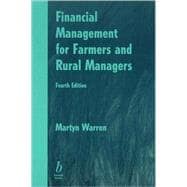
What is included with this book?
Martyn Warren is the author of Financial Management for Farmers and Rural Managers, 4th Edition, published by Wiley.
| Preface to the Fourth Edition | ix | (2) | |||
| Acknowledgements | xi | ||||
| Part 1: Basic Issues | 1 | (62) | |||
|
3 | (6) | |||
|
3 | (3) | |||
|
6 | (3) | |||
|
9 | (19) | |||
|
9 | (1) | |||
|
10 | (4) | |||
|
14 | (2) | |||
|
16 | (2) | |||
|
18 | (2) | |||
|
20 | (8) | |||
|
28 | (14) | |||
|
28 | (1) | |||
|
29 | (4) | |||
|
33 | (9) | |||
|
42 | (11) | |||
|
42 | (1) | |||
|
43 | (1) | |||
|
44 | (1) | |||
|
45 | (5) | |||
|
50 | (3) | |||
|
53 | (10) | |||
|
53 | (3) | |||
|
56 | (4) | |||
|
60 | (3) | |||
| Part 2: Basic Budgeting | 63 | (58) | |||
|
65 | (24) | |||
|
65 | (1) | |||
|
66 | (10) | |||
|
76 | (13) | |||
|
89 | (17) | |||
|
89 | (1) | |||
|
90 | (6) | |||
|
96 | (3) | |||
|
99 | (7) | |||
|
106 | (5) | |||
|
106 | (1) | |||
|
107 | (4) | |||
|
111 | (10) | |||
|
111 | (2) | |||
|
113 | (8) | |||
| Part 3: Financial History | 121 | (52) | |||
|
123 | (21) | |||
|
123 | (2) | |||
|
125 | (6) | |||
|
131 | (5) | |||
|
136 | (8) | |||
|
144 | (16) | |||
|
144 | (6) | |||
|
150 | (6) | |||
|
156 | (4) | |||
|
160 | (13) | |||
|
160 | (1) | |||
|
160 | (2) | |||
|
162 | (5) | |||
|
167 | (1) | |||
|
168 | (1) | |||
|
168 | (2) | |||
|
170 | (3) | |||
| Part 4: Controlling the Business | 173 | (28) | |||
|
175 | (8) | |||
|
175 | (1) | |||
|
176 | (2) | |||
|
178 | (2) | |||
|
180 | (3) | |||
|
183 | (18) | |||
|
183 | (2) | |||
|
185 | (1) | |||
|
186 | (2) | |||
|
188 | (2) | |||
|
190 | (1) | |||
|
191 | (3) | |||
|
194 | (3) | |||
|
197 | (4) | |||
| Part 5: More on Planning and Control | 201 | (70) | |||
|
203 | (8) | |||
|
203 | (1) | |||
|
204 | (1) | |||
|
204 | (3) | |||
|
207 | (1) | |||
|
207 | (1) | |||
|
208 | (1) | |||
|
209 | (1) | |||
|
210 | (1) | |||
|
211 | (13) | |||
|
211 | (1) | |||
|
211 | (2) | |||
|
213 | (3) | |||
|
216 | (2) | |||
|
218 | (2) | |||
|
220 | (4) | |||
|
224 | (15) | |||
|
224 | (1) | |||
|
224 | (8) | |||
|
232 | (2) | |||
|
234 | (5) | |||
|
239 | (18) | |||
|
239 | (1) | |||
|
239 | (3) | |||
|
242 | (4) | |||
|
246 | (4) | |||
|
250 | (7) | |||
|
257 | (7) | |||
|
257 | (1) | |||
|
258 | (4) | |||
|
262 | (2) | |||
|
264 | (7) | |||
|
264 | (1) | |||
|
264 | (1) | |||
|
265 | (2) | |||
|
267 | (1) | |||
|
268 | (3) | |||
| Appendix A. Personal Computers in Management | 271 | (17) | |||
| A.1 Introduction | 271 | (1) | |||
| A.2 Computers and farming | 271 | (2) | |||
| A.3 General business applications | 273 | (15) | |||
| Index | 288 |
The New copy of this book will include any supplemental materials advertised. Please check the title of the book to determine if it should include any access cards, study guides, lab manuals, CDs, etc.
The Used, Rental and eBook copies of this book are not guaranteed to include any supplemental materials. Typically, only the book itself is included. This is true even if the title states it includes any access cards, study guides, lab manuals, CDs, etc.